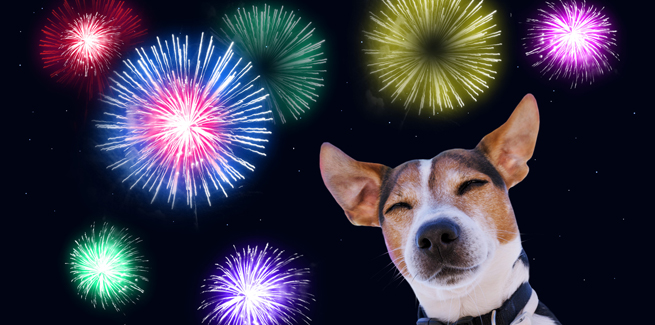Tell clients to check the chip (and other safety tips for the Fourth of July)

Most people love Fourth of July fireworks. Pets, not so much.
Noisy fireworks can terrify pets and trigger an instinctive fight-or-flight response. Faced with repeated thundering explosives, fleeing is the natural reaction. According to statistics, animal control officials across the country see a 30%–60% increase in lost pets each year between July fourth and sixth; July fifth is typically one of the busiest days of the year for animal shelters.
That’s when a microchip can come in mighty handy.
AAHA’s Universal Pet Microchip Lookup Tool is a free, web-based resource that can assist with microchip identification. The tool helps reunite pets and owners by checking the databases of participating pet-recovery services to determine with which company the chip is registered. The tool can be used by veterinarians, animal shelters—anyone with a microchip scanner.
Annalisa Berns, a professional pet detective and owner of Pet Search and Rescue in Southern California, has found countless lost pets thanks to microchips.
But Berns stresses that regularly updating contact information on the pet’s microchip is almost as important as implanting the chip itself; if someone does find a lost pet and takes him to a veterinarian to be scanned, an outdated phone number and address won’t be of much use.
Berns says hospitals can ensure that microchips are even more effective by addressing with clients a huge misconception that many people have about microchips: Pet microchips are not GPS-tracking devices. Berns says that a large percentage of pet owners believe that they are.
Fireworks-inspired flight is only the most obvious danger the Fourth of July can pose for pets: holiday food and beverages are a potential health risk, and summer heat and travel can be hazardous, too.
As we head into the holiday, pet owners may ask their veterinarians for suggestions on how to keep their pets safe. So, in addition to microchipping (and keeping contact info up to date), encourage your clients to follow these tips to make it a safe holiday for pets and people alike.
- When the fireworks start, keep pets confined indoors, in a windowless room if possible, and not in a crate. Animals have been known to leap through glass windows and even eat through crates, harming themselves, to get away from the noise of fireworks.
- Consider administering an antianxiety medication to your pet prior to festivities involving fireworks. Ask your veterinarian for their recommendation.
- If possible, stay with your pet during the fireworks. Your presence will soothe and reassure him, helping to keep stress low.
- Keep your pet from foraging through leftover picnic foods in the backyard. Corncobs, ribs, hot dogs, and other picnic fare can cause gastrointestinal distress to animals.
- Make sure gates stay closed in the yard. With holiday guests coming and going, it’s easy leave one open long enough for a pet to slip away unseen.
- If multiple dogs from different households are present, monitor their play. Separate them as needed to avoid fights and injuries.
- If the party is at someone else’s house, keep your pet at home and inside. It can also help to create white noise by turning on the TV or radio, which can distract your pet from fireworks noise and help keep him calm.
Pass on these tips to pet owners to help everyone have a safe and happy Fourth of July!
Photo credit: © iStock/Kira-Yan



